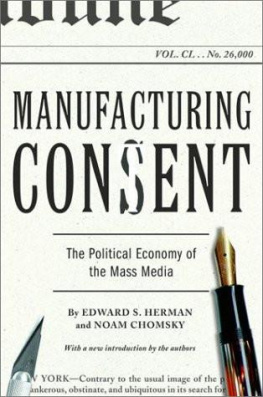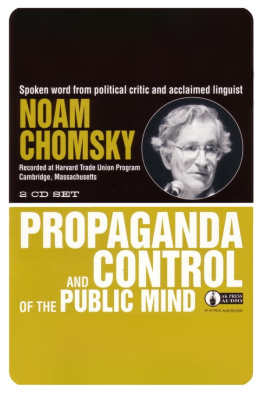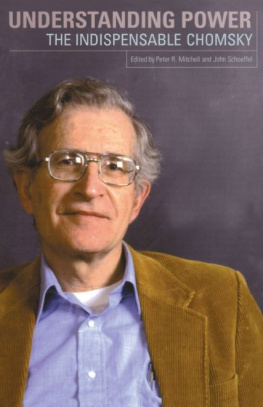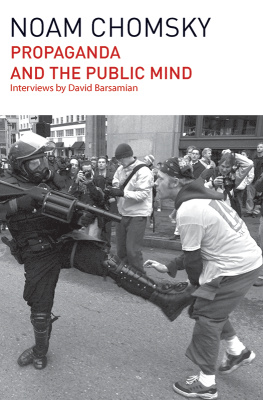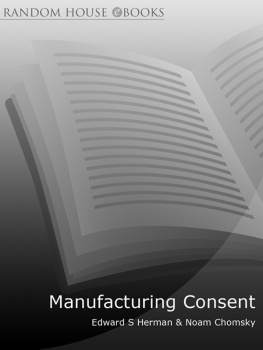Edward S. Herman - Manufacturing Consent: The Political Economy of the Mass Media
Here you can read online Edward S. Herman - Manufacturing Consent: The Political Economy of the Mass Media full text of the book (entire story) in english for free. Download pdf and epub, get meaning, cover and reviews about this ebook. year: 2010, publisher: Vintage Digital;Pantheon, genre: Politics. Description of the work, (preface) as well as reviews are available. Best literature library LitArk.com created for fans of good reading and offers a wide selection of genres:
Romance novel
Science fiction
Adventure
Detective
Science
History
Home and family
Prose
Art
Politics
Computer
Non-fiction
Religion
Business
Children
Humor
Choose a favorite category and find really read worthwhile books. Enjoy immersion in the world of imagination, feel the emotions of the characters or learn something new for yourself, make an fascinating discovery.
- Book:Manufacturing Consent: The Political Economy of the Mass Media
- Author:
- Publisher:Vintage Digital;Pantheon
- Genre:
- Year:2010
- Rating:3 / 5
- Favourites:Add to favourites
- Your mark:
Manufacturing Consent: The Political Economy of the Mass Media: summary, description and annotation
We offer to read an annotation, description, summary or preface (depends on what the author of the book "Manufacturing Consent: The Political Economy of the Mass Media" wrote himself). If you haven't found the necessary information about the book — write in the comments, we will try to find it.
In this pathbreaking work, now with a new introduction, Edward S. Herman and Noam Chomsky show that, contrary to the usual image of the news media as cantankerous, obstinate, and ubiquitous in their search for truth and defense of justice, in their actual practice they defend the economic, social, and political agendas of the privileged groups that dominate domestic society, the state, and the global order.
Based on a series of case studiesincluding the medias dichotomous treatment of worthy versus unworthy victims, legitimizing and meaningless Third World elections, and devastating critiques of media coverage of the U.S. wars against IndochinaHerman and Chomsky draw on decades of criticism and research to propose a Propaganda Model to explain the medias behavior and performance. Their new introduction updates the Propaganda Model and the earlier case studies, and it discusses several other applications. These include the manner in which the media covered the passage of the North American Free Trade Agreement and subsequent Mexican financial meltdown of 1994-1995, the medias handling of the protests against the World Trade Organization, World Bank, and International Monetary Fund in 1999 and 2000, and the medias treatment of the chemical industry and its regulation. What emerges from this work is a powerful assessment of how propagandistic the U.S. mass media are, how they systematically fail to live up to their self-image as providers of the kind of information that people need to make sense of the world, and how we can understand their function in a radically new way.
Amazon.com ReviewAn absolutely brilliant analysis of the ways in which individuals and organizations of the media are influenced to shape the social agendas of knowledge and, therefore, belief. Contrary to the popular conception of members of the press as hard-bitten realists doggedly pursuing unpopular truths, Herman and Chomsky prove conclusively that the free-market economics model of media leads inevitably to normative and narrow reporting. Whether or not youve seen the eye-opening movie, buy this book, and you will be a far more knowledgeable person and much less prone to having your beliefs manipulated as easily as the press.
From Publishers WeeklyHerman of Wharton and Chomsky of MIT lucidly document their argument that Americas government and its corporate giants exercise control over what we read, see and hear. The authors identify the forces that they contend make the national media propagandisticthe major three being the motivation for profit through ad revenue, the medias close links to and often ownership by corporations, and their acceptance of information from biased sources. In five case studies, the writers show how TV, newspapers and radio distort world events. For example, the authors maintain that it would have been very difficult for the Guatemalan government to murder tens of thousands over the past decade if the U.S. press had provided the kind of coverage they gave to the difficulties of Andrei Sakharov or the murder of Jerzy Popieluszko in Poland. Such allegations would be routine were it not for the excellent research behind this books controversial charges. Extensive evidence is calmly presented, and in the end an indictment against the guardians of our freedoms is substantiated. A disturbing picture emerges of a news system that panders to the interests of Americas privileged and neglects its duties when the concerns of minority groups and the underclass are at stake. First serial to the Progressive.
Copyright 1988 Reed Business Information, Inc.
Edward S. Herman: author's other books
Who wrote Manufacturing Consent: The Political Economy of the Mass Media? Find out the surname, the name of the author of the book and a list of all author's works by series.

